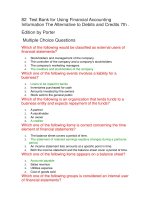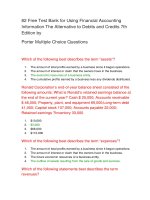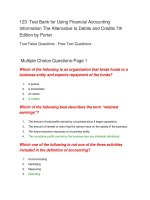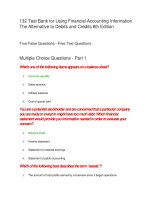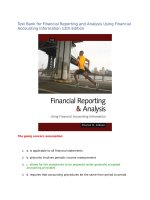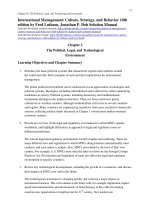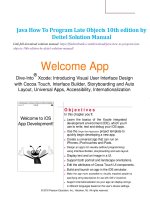Solution manual for using financial accounting information the alternative to debits and credits 10th edition by porter
Bạn đang xem bản rút gọn của tài liệu. Xem và tải ngay bản đầy đủ của tài liệu tại đây (397.81 KB, 35 trang )
Solution Manual for Using Financial Accounting Information The Alternative to Debits and Credits
Full file at />
CHAPTER 1
Accounting as a Form
of Communication
OVERVIEW OF EXERCISES, PROBLEMS, AND CASES
Learning Outcomes
Exercises
Estimated
Time in
Minutes
Level
Module 1
1. Explain what business is about.
2. Distinguish among the forms of organization.
3. Describe the various types of business activities.
1
5
Mod
4. Define accounting and identify the primary users of accounting
information and their needs.
2
15*
5
10
Easy
Mod
5. Explain the purpose of each of the financial statements
and the relationships among them and prepare a set of
simple statements.
3
4
5
6
7
8
9
10
11
14
15*
16*
15
10
10
15
10
20
15
10
10
15
10
10
Mod
Mod
Mod
Easy
Easy
Diff
Mod
Mod
Mod
Mod
Mod
Mod
6. Identify and explain the primary assumptions made in
preparing financial statements.
12
16*
10
10
Mod
Mod
7. Identify the various groups involved in setting accounting standards
and the role of auditors in determining whether the standards are
followed.
13
10
Mod
Module 2
Module 3
8. Explain the critical role that ethics plays in providing useful
financial information.
*Exercise, problem, or case covers two or more learning outcomes
Level = Difficulty levels: Easy; Moderate (Mod); Difficult (Diff)
1-1
© 2018 Cengage Learning. All Rights Reserved. May not be scanned, copied or duplicated, or posted to a publicly accessible website, in whole or in part.
Full file at />
Solution Manual for Using Financial Accounting Information The Alternative to Debits and Credits
Full file 1-2
at />USING FINANCIAL ACCOUNTING INFORMATION SOLUTIONS MANUAL
Learning Outcomes
Problems
and
Alternates
Estimated
Time in
Minutes
Level
Module 1
1. Explain what business is about.
2. Distinguish among the forms of organization.
3. Describe the various types of business activities.
Module 2
4. Define accounting and identify the primary users of accounting
information and their needs.
5. Explain the purpose of each of the financial statements
and the relationships among them and prepare a set of
simple statements.
1
2
9
30
20
20
Mod
Mod
Mod
3
4
5
6
7
8
10*
30
30
60
45
60
25
45
Easy
Easy
Mod
Mod
Diff
Mod
Diff
10*
45
Diff
Module 3
6. Identify and explain the primary assumptions made in
preparing financial statements.
7. Identify the various groups involved in setting accounting standards
and the role of auditors in determining whether the standards are
followed.
8. Explain the critical role that ethics plays in providing useful
financial information.
*Exercise, problem, or case covers two or more learning outcomes
Level = Difficulty levels: Easy; Moderate (Mod); Difficult (Diff)
© 2018 Cengage Learning. All Rights Reserved. May not be scanned, copied or duplicated, or posted to a publicly accessible website, in whole or in part.
Full file at />
Solution Manual for Using Financial Accounting Information The Alternative to Debits and Credits
Full file at />
CHAPTER 1 • ACCOUNTING AS A FORM OF COMMUNICATION
Learning Outcomes
Cases
Estimated
Time in
Minutes
1-3
Level
Module 1
1. Explain what business is about.
2. Distinguish among the forms of organization.
3. Describe the various types of business activities.
Module 2
4. Define accounting and identify the primary users of accounting
information and their needs.
1*
4
6*
25
30
75
Mod
Mod
Diff
5. Explain the purpose of each of the financial statements
and the relationships among them and prepare a set of
simple statements.
1*
2
3
5
6*
25
20
30
60
75
Mod
Mod
Mod
Diff
Diff
6*
7
75
20
Diff
Mod
Module 3
6. Identify and explain the primary assumptions made in
preparing financial statements.
7. Identify the various groups involved in setting accounting standards
and the role of auditors in determining whether the standards are
followed.
8. Explain the critical role that ethics plays in providing useful
financial information.
*Exercise, problem, or case covers two or more learning outcomes
Level = Difficulty levels: Easy; Moderate (Mod); Difficult (Diff)
© 2018 Cengage Learning. All Rights Reserved. May not be scanned, copied or duplicated, or posted to a publicly accessible website, in whole or in part.
Full file at />
Solution Manual for Using Financial Accounting Information The Alternative to Debits and Credits
Full file 1-4
at />USING FINANCIAL ACCOUNTING INFORMATION SOLUTIONS MANUAL
EXERCISES
EXERCISE 1-1 TYPES OF BUSINESS ACTIVITIES
LO 3
F
1. Issued shares of stock to each of the four owners.
I
2. Purchased two limousines.
O
3. Paid first month’s rent for use of garage.
F
4. Obtained loan from local bank.
O
5. Received cash from customer for trip to the airport.
O
6. Paid driver first week’s wages.
I
7. Purchased 500-gallon fuel tank.
LO 4
EXERCISE 1-2 USERS OF ACCOUNTING INFORMATION AND THEIR NEEDS
1. Company management
2. Stockholder
3. Labor union
4. Securities and Exchange Commission
5. Banker
6. Supplier
7. Internal Revenue Service
LO 5
EXERCISE 1-3 THE ACCOUNTING EQUATION
Case 1:
A
$125,000
SE
=
=
=
L
$75,000
+
+
SE
SE
$50,000
Case 2:
A
$400,000
L
=
=
=
L
L
$300,000
+
+
SE
$100,000
Case 3:
A
A
A
=
=
=
L
$320,000
$415,000
+
+
SE
$95,000
© 2018 Cengage Learning. All Rights Reserved. May not be scanned, copied or duplicated, or posted to a publicly accessible website, in whole or in part.
Full file at />
Solution Manual for Using Financial Accounting Information The Alternative to Debits and Credits
Full file at />LO 5
1.
2.
CHAPTER 1 • ACCOUNTING AS A FORM OF COMMUNICATION
1-5
EXERCISE 1-4 THE ACCOUNTING EQUATION
A
$500,000
SE
A
($500,000 + $100,000)
SE
=
=
=
L
$250,000
+
+
SE
SE
$250,000
=
=
=
L
($250,000 + $77,000)
+
+
SE
SE
$273,000*
*SE = ($500,000 + $100,000) – ($250,000 + $77,000) = $273,000
3.
A
A
A
$475,000
*From (1) above
=
=
=
L
($250,000 + $33,000)
$283,000
4.
A
$1,000,000
L
*From (1) above
=
=
=
L
L
$750,000
LO 5
1.
+
SE
+ ($250,000* – $58,000)
+
$192,000
+
+
SE
$250,000*
EXERCISE 1-5 THE ACCOUNTING EQUATION
A
Beginning of year
$100,000
Net income
Dividends
Stockholders’ equity at end of year
=
=
L
$80,000
+
+
+
–
SE
$20,000
25,000
0
$45,000
A
$60,000*
=
=
L
$40,000
+
+
SE
$20,000
2.
End of year (EOY)
Reduce by half to beginning
of year:
Assets, beginning of year
divided by 2
$30,000
*Hint: First, solve for EOY asset amount = $40,000 + $20,000 = $60,000.
3.
Beginning of year (BOY)
Triples during year
Liabilities, end of year
A
$30,000
=
=
L
$20,000*
×
3
$60,000
+
+
SE
$10,000
*Hint: First, solve for BOY liability amount = $30,000 – $10,000 = $20,000.
© 2018 Cengage Learning. All Rights Reserved. May not be scanned, copied or duplicated, or posted to a publicly accessible website, in whole or in part.
Full file at />
Solution Manual for Using Financial Accounting Information The Alternative to Debits and Credits
Full file 1-6
at />USING FINANCIAL ACCOUNTING INFORMATION SOLUTIONS MANUAL
LO 5
EXERCISE 1-6 CHANGES IN OWNERS’ EQUITY
1. First, compute the amount of stockholders’ equity at the end of each year. Then,
compute the change.
2015:
A
$25,000
SE
=
=
=
L
$12,000
+
+
SE
SE
$13,000
2016:
A
$79,000
SE
=
=
=
L
$67,000
+
+
SE
SE
$12,000
2017:
A
$184,000
SE
=
=
=
L
$137,000
+
+
SE
SE
$47,000
Change in stockholders’ equity during 2016:
$12,000 – $13,000 = ($1,000)
Change in stockholders’ equity during 2017:
$47,000 – $12,000 = $35,000
2. 2016:
($1,000) = Income – $0 in dividends
Net loss = ($1,000)
3. 2017:
$35,000 = Income – $10,000 in dividends
Net income = $45,000*
Beginning of the year SE
$12,000
Contributed capital
Dividends
NI
0
(10,000)
x
=?
= End of year SE
$47,000
It has to be $45,000 ($12,000 –
$10,000 + $45,000 = $47,000)
© 2018 Cengage Learning. All Rights Reserved. May not be scanned, copied or duplicated, or posted to a publicly accessible website, in whole or in part.
Full file at />
Solution Manual for Using Financial Accounting Information The Alternative to Debits and Credits
Full file at />LO 5
CHAPTER 1 • ACCOUNTING AS A FORM OF COMMUNICATION
1-7
EXERCISE 1-7 THE ACCOUNTING EQUATION
(In thousands of dollars)
A
=
L
+
CS
+
Case 1:
40
Liabilities = 9
=
L
+
10
+
(15
+
8
–
2)
Case 2:
A
Assets = 34
=
15
+
5
+
(8
+
7
–
1)
=
25
+
20
+
(10
+ Income* –
3)
10
+
15
+
(20
+
Case 3:
75
Income = 23*
75 – 52 = 23*
Case 4:
50
=
Dividends = 4*
50 = 54 – 4*
LO 5
(Beg. RE + Income – Div.)
9
– Div*.)
EXERCISE 1-8 CLASSIFICATION OF FINANCIAL STATEMENT ITEMS
Appears on the
Classified as
1.
IS
E
2.
BS
A
3.
BS
L
4.
IS
R
5.
BS
SE
6.
BS
A
7.
BS
A
8.
IS
E
9.
BS
SE
© 2018 Cengage Learning. All Rights Reserved. May not be scanned, copied or duplicated, or posted to a publicly accessible website, in whole or in part.
Full file at />
Solution Manual for Using Financial Accounting Information The Alternative to Debits and Credits
Full file 1-8
at />USING FINANCIAL ACCOUNTING INFORMATION SOLUTIONS MANUAL
LO 5
EXERCISE 1-9 CLASSIFICATION OF FINANCIAL STATEMENT ITEMS
Item
Appears on the
Classified as
1. Trade and other receivables, net
BS
A
2. Class A common stock
BS
SE
3. Inventories
BS
A
4. Admissions
IS
R
5. Cost of concessions
IS
E
6. Equipment
BS
A
7. Accounts payable
BS
L
8. Retained earnings
BS
SE
9. Interest expense, net
IS
E
BS
L
10. Long-term debt, less current portion
LO 5
1.
EXERCISE 1-10 NET INCOME (OR LOSS) AND RETAINED EARNINGS
Revenue
$25,000
–
–
Expenses
($6,500 + $12,000)
2. Retained Earnings,
Beginning of Year
$8,500
Net
Income
$6,500
+
+
=
=
–
–
3. Total Assets:
Cash .....................................
Accounts receivable .............
Office equipment ..................
Total assets .......................
$13,000
4,500
7,500
$25,000
4. Total Liabilities:
Accounts payable .................
$5,000
Net Income
$6,500
Dividends
$3,000
=
=
Retained Earnings,
End of Year
$12,000
5. Stockholders’ Equity:
Capital Stock +
Retained Earnings
= Stockholders’ Equity
$8,000
+
$12,000
=
$20,000
(Or $25,000 in total assets less $5,000 in total liabilities.)
6.
A
$25,000
=
=
L
$5,000
+
+
SE
$20,000
© 2018 Cengage Learning. All Rights Reserved. May not be scanned, copied or duplicated, or posted to a publicly accessible website, in whole or in part.
Full file at />
Solution Manual for Using Financial Accounting Information The Alternative to Debits and Credits
Full file at />LO 5
CHAPTER 1 • ACCOUNTING AS A FORM OF COMMUNICATION
1-9
EXERCISE 1-11 STATEMENT OF RETAINED EARNINGS
ACE CORPORATION
STATEMENT OF RETAINED EARNINGS
FOR THE MONTH ENDED FEBRUARY 28, 2017
Retained earnings, beginning of month .............................................
Net income ........................................................................................
Dividends for the month ....................................................................
Retained earnings, end of month ......................................................
$229,800*
14,000**
(5,000)
$238,800
*$235,800 + $83,000 – $89,000
**$96,000 – $82,000
LO 6
EXERCISE 1-12 ACCOUNTING PRINCIPLES AND ASSUMPTIONS
1. Going concern (also economic entity)
2. Cost principle
3. Economic entity
4. Monetary unit
5. Time period
LO 7
EXERCISE 1-13 ORGANIZATIONS AND ACCOUNTING
1. Securities and Exchange Commission
2. Financial Accounting Standards Board
3. American Institute of Certified Public Accountants
4. International Accounting Standards Board
© 2018 Cengage Learning. All Rights Reserved. May not be scanned, copied or duplicated, or posted to a publicly accessible website, in whole or in part.
Full file at />
Solution Manual for Using Financial Accounting Information The Alternative to Debits and Credits
Full file 1-10
at />USING FINANCIAL ACCOUNTING INFORMATION SOLUTIONS MANUAL
LO 5
EXERCISE 1-14 CLASSIFICATION OF ITEMS ON THE STATEMENT OF CASH FLOWS
Item
Section
1. Cash paid for land
I
2. Cash received from issuance of note
F
3. Cash paid for dividends
F
4. Cash received from issuance of capital stock
F
5. Cash collected from customers
O
6. Cash paid for income taxes
O
MULT I-CONCEPT EXERCISES
LO 4,5
EXERCISE 1-15 USERS OF ACCOUNTING INFORMATION AND THE FINANCIAL
STATEMENTS
USER
Stockholder
Banker
Supplier
Stockholder
Advertising account manager
Banker
FINANCIAL STATEMENT
IS
BS
BS
RE*
SCF**
BS
*Amount of dividends declared would appear on the statement of retained earnings.
Amount paid would appear on the statement of cash flows.
**Amount spent on advertising would appear on the statement of cash flows (assuming
use of the direct method). Amount incurred would appear on the income statement.
LO 5,6
EXERCISE 1-16 CHIPOTLE’S LAND
Land would be included in “Leasehold improvements, property and equipment, net” on
Chipotle’s balance sheet. The amount represents how much the company paid for the
land, that is, its cost. Under current standards, the company is required to carry its land
at historical cost rather than market value. The subjectivity in determining market value
supports the practice of carrying assets at their cost.
© 2018 Cengage Learning. All Rights Reserved. May not be scanned, copied or duplicated, or posted to a publicly accessible website, in whole or in part.
Full file at />
Solution Manual for Using Financial Accounting Information The Alternative to Debits and Credits
Full file at />
CHAPTER 1 • ACCOUNTING AS A FORM OF COMMUNICATION
1-11
PROBLEMS
LO 4
PROBLEM 1-1 YOU WON THE LOTTERY
Obviously, there is no single, correct answer to this problem. Students should start by
considering their personal circumstances and preference for risk. They should also consider their liquidity requirements. From this point, it is appropriate to consider sources of
information.
Students should provide specific justification for their chosen investments. The “bottom line” is that students should justify their selections using financial information from
as many sources as is cost effective and relate their choices to their preference or aversion to risk.
Following are guidelines to be used:
Options
Issues
Risk
Stock
High
Bonds
Medium
Bank deposit
Low
Information
needed
Market price
Dividends
Market price
Interest rate
Maturity date
Interest rate
Information
sources
Annual reports
Investor newsletters
Newspapers,
business
periodicals
Same as for
the stock
Bank
advertising
Newspaper
articles
Additional
information
needed
Earnings
forecasts
Brokerage fees
Alternative
rates
Brokerage fees
Penalties for
early
withdrawal
This problem provides the instructor with an opportunity to introduce the concept of the
time value of money. Certainly, it would be preferable to receive $1 million today, rather
than $200,000 over each of the next five years. If a lump sum is received immediately, it
could be put into one of the investments chosen, as opposed to spreading the investment over a five-year period.
© 2018 Cengage Learning. All Rights Reserved. May not be scanned, copied or duplicated, or posted to a publicly accessible website, in whole or in part.
Full file at />
Solution Manual for Using Financial Accounting Information The Alternative to Debits and Credits
Full file 1-12
at />USING FINANCIAL ACCOUNTING INFORMATION SOLUTIONS MANUAL
LO 4
PROBLEM 1-2 USERS OF ACCOUNTING INFORMATION AND THEIR NEEDS
Information
1.
2.
3.
4.
5.
LO 5
Management
a.
a.
a.
a.
a.
Stockholders
b.
c.
c.
b.
b.
Banker
a.
a.
a.
a.
b.
PROBLEM 1-3 BALANCE SHEET
FREESCIA CORPORATION
BALANCE SHEET
END OF THE YEAR
Assets
Liabilities and Stockholders’ Equity
Cash .....................................
Accounts receivable .............
Office equipment ..................
Buildings...............................
$
4,220
23,920
12,000
85,000
Total assets ..........................
$125,140
Accounts payable ......................
Notes payable............................
Capital stock ..............................
Retained earnings .....................
Total liabilities and
stockholders’ equity ..............
$ 12,550
50,000
25,000
37,590
$125,140
Items not shown on a balance sheet and where they would appear:
Advertising expense—income statement
Salary and wage expense—income statement
Sales revenue—income statement
© 2018 Cengage Learning. All Rights Reserved. May not be scanned, copied or duplicated, or posted to a publicly accessible website, in whole or in part.
Full file at />
Solution Manual for Using Financial Accounting Information The Alternative to Debits and Credits
Full file at />LO 5
CHAPTER 1 • ACCOUNTING AS A FORM OF COMMUNICATION
1-13
PROBLEM 1-4 CORRECTED BALANCE SHEET
1.
AVON CONSULTING INC.
BALANCE SHEET
END OF THE YEAR
Assets
Cash ...............................
Accounts receivable ........
Supplies ..........................
Furniture and
equipment ..................
Total assets ....................
Liabilities and Stockholders’ Equity
$21,000
16,000
9,000
Accounts payable ......................
Capital stock ..............................
Retained earnings .....................
$13,000
20,000
56,000*
43,000
$89,000
Total liabilities and
stockholders’ equity ..............
$89,000
*$72,000 – $16,000
2. Memorandum to the company president:
TO:
Company president
FROM:
Student’s name
DATE:
Beginning of following year
SUBJECT:
Corrected balance sheet
Attached please find the original balance sheet your assistant prepared, along with a
corrected version of that same statement. The differences can be explained as follows:
1. The balance sheet is always as of a certain date, in this case, the end of the current year, rather than a period of time, such as a year.
2. Accounts payable should be classified as a liability.
3. Cash dividends do not belong on the balance sheet; this amount should appear
instead on the statement of retained earnings for the year.
4. Accounts receivable should be classified as an asset.
5. Net income for the year does not belong on the balance sheet; this amount
should appear instead on the income statement and on the statement of retained
earnings for the year.
6. Supplies should be classified as an asset.
7. Retained earnings should appear with capital stock as a component of stockholders’ equity on the balance sheet. Since this is the first year of operations, the
Retained Earnings balance comprises the net income for the year less the cash
dividends.
8. Totals were added as necessary to provide summary information. Totals also
verify that the balance sheet is in balance, i.e., that assets = liabilities + stockholders’ equity.
© 2018 Cengage Learning. All Rights Reserved. May not be scanned, copied or duplicated, or posted to a publicly accessible website, in whole or in part.
Full file at />
Solution Manual for Using Financial Accounting Information The Alternative to Debits and Credits
Full file 1-14
at />USING FINANCIAL ACCOUNTING INFORMATION SOLUTIONS MANUAL
LO 5
1.
PROBLEM 1-5 INCOME STATEMENT, STATEMENT OF RETAINED EARNINGS,
AND BALANCE SHEET
MAPLE PARK THEATRES CORP.
INCOME STATEMENT
FOR THE MONTH ENDED SEPTEMBER 30, 2017
Revenues:
Ticket sales..................................................................
Concessions revenue ..................................................
Total revenues .......................................................
Expenses:
Rent expense—movies ...............................................
Cost of concessions sold .............................................
Advertising expense ....................................................
Salaries and wages expense .......................................
Water, gas, and electricity ...........................................
Total expenses .......................................................
Net income ........................................................................
2.
$95,100
60,300
$155,400
$50,600
23,450
14,500
46,490
6,700
141,740
$ 13,660
MAPLE PARK THEATRES CORP.
STATEMENT OF RETAINED EARNINGS
FOR THE MONTH ENDED SEPTEMBER 30, 2017
Retained earnings, beginning balance, September 1, 2017 ...................
Net income for September ......................................................................
Dividends for September ........................................................................
Retained earnings, ending balance, September 30, 2017 ......................
3.
$73,780
13,660
(8,400)
$79,040
MAPLE PARK THEATRES CORP.
BALANCE SHEET
SEPTEMBER 30, 2017
Assets
Cash ...............................
Accounts receivable ........
Land ................................
Buildings .........................
Furniture and fixtures ......
Projection equipment ......
Total assets ....................
Liabilities and Stockholders’ Equity
$ 15,230
6,410
26,000
60,000
34,000
25,000
$166,640
Accounts payable ......................
Notes payable............................
Capital stock ..............................
Retained earnings .....................
$ 17,600
20,000
50,000
79,040*
Total liabilities and
stockholders’ equity ..............
$166,640
*From (2) above. Note that retained earnings at September 30, 2017, is not $73,780
as shown in the list of accounts. This was the amount of retained earnings at the
beginning of the month.
© 2018 Cengage Learning. All Rights Reserved. May not be scanned, copied or duplicated, or posted to a publicly accessible website, in whole or in part.
Full file at />
Solution Manual for Using Financial Accounting Information The Alternative to Debits and Credits
Full file at />
CHAPTER 1 • ACCOUNTING AS A FORM OF COMMUNICATION
1-15
PROBLEM 1-5 (Concluded)
4. On the basis of these statements alone, Maple Park would appear to be a good
candidate for an investment. It is operating at a profit and is paying dividends. Before
one makes an investment in Maple Park stock, it would be useful to see the statement of cash flows. Information about the current market price of the stock, the
competitors, the general outlook for the industry, the age of the various long-term
assets, and the due date of the note payable would also be useful before one makes
an investment. The financial statements of earlier periods would be helpful for purposes of making comparisons.
LO 5
1.
PROBLEM 1-6 INCOME STATEMENT AND BALANCE SHEET
GREEN BAY CORPORATION
INCOME STATEMENT
FOR THE MONTH ENDED JULY 31, 2017
Revenues:
Fishing revenue ...........................................................
Passenger service revenue .........................................
Total revenues .......................................................
Expenses:
Rent expense ..............................................................
Salary and wage expense ...........................................
Total expenses .......................................................
Net income ........................................................................
2.
$21,300
12,560
$33,860
$ 4,000
18,230
22,230
$11,630
GREEN BAY CORPORATION
BALANCE SHEET
JULY 31, 2017
Assets
Liabilities and Stockholders’ Equity
Cash ...............................
Accounts receivable ........
Boats...............................
$
7,730
18,500
80,000
Total assets ....................
$106,230
Notes payable............................
Capital stock ..............................
Retained earnings .....................
Total liabilities and
stockholders’ equity ..............
$ 60,000
40,000
6,230*
$106,230
*Beginning retained earnings + net income – dividends:
$0 + $11,630 – $5,400
3. To fully assess Green Bay’s long-term viability, you would need the following information about the $60,000 note payable:
When is it due?
What is the interest rate?
Is interest paid periodically or only at maturity?
Have any assets been offered as collateral for the loan?
© 2018 Cengage Learning. All Rights Reserved. May not be scanned, copied or duplicated, or posted to a publicly accessible website, in whole or in part.
Full file at />
Solution Manual for Using Financial Accounting Information The Alternative to Debits and Credits
Full file 1-16
at />USING FINANCIAL ACCOUNTING INFORMATION SOLUTIONS MANUAL
LO 5
PROBLEM 1-7 CORRECTED FINANCIAL STATEMENTS
1.
HOMETOWN CLEANERS INC.
INCOME STATEMENT
FOR THE YEAR ENDED DECEMBER 31, 2017
Revenues:
Cleaning revenue—credit sales ...................................
Cleaning revenue—cash sales ....................................
Total revenues .......................................................
Expenses:
Utilities .........................................................................
Salaries and wages .....................................................
Total expenses .......................................................
Net income ........................................................................
2.
$26,200
32,500
$58,700
$12,200
17,100
29,300
$29,400
HOMETOWN CLEANERS INC.
STATEMENT OF RETAINED EARNINGS
FOR THE YEAR ENDED DECEMBER 31, 2017
Retained earnings, beginning of year .....................................................
Net income for the year...........................................................................
Dividends for the year .............................................................................
Retained earnings, end of year ...............................................................
$42,700*
29,400
(4,000)
$68,100
*Given in text.
3.
HOMETOWN CLEANERS INC.
BALANCE SHEET
DECEMBER 31, 2017
Assets
Liabilities and Stockholders’ Equity
Cash ...............................
Accounts receivable ........
Building and equipment ..
Land ................................
$
7,400
15,200
80,000
40,000
Total assets ....................
$142,600
Accounts payable ......................
Notes payable............................
Capital stock ..............................
Retained earnings .....................
Total liabilities and
stockholders’ equity ..............
$
4,500
50,000
20,000
68,100*
$142,600
*From (2) above. Note that retained earnings at December 31, 2017, is not $42,700
as given in text. This was the amount of retained earnings at the beginning of the
year.
© 2018 Cengage Learning. All Rights Reserved. May not be scanned, copied or duplicated, or posted to a publicly accessible website, in whole or in part.
Full file at />
Solution Manual for Using Financial Accounting Information The Alternative to Debits and Credits
Full file at />
CHAPTER 1 • ACCOUNTING AS A FORM OF COMMUNICATION
1-17
PROBLEM 1-7 (Concluded)
4. Memorandum to the company president:
TO:
Company president
FROM:
Student’s name
DATE:
January 1, 2018
SUBJECT:
Corrected income statement
Attached please find the original income statement you prepared, along with a corrected version of that same statement. Fortunately, your disappointment with the
2017 net income is not warranted, as you will see from my revised statement. The
difference between the net income on the original income statement of $9,900 and
the revised amount of $29,400, or $19,500, can be explained as follows:
1. Accounts receivable of $15,200 does not belong on the income statement; instead, services provided on account of $26,200 should be shown on the income
statement; the difference is $11,000.
2. Dividends are not an expense, and thus they do not belong on the income statement: $4,000.
3. Accounts payable is a liability and appears on the balance sheet: $4,500.
These corrections result in increased income of $19,500. Also, note that notes
payable should be reported on the balance sheet as a liability, not as an offset to
building and equipment. Please let me know if I can be of any further assistance in
interpreting the results of our operations for 2017.
LO 5
1.
PROBLEM 1-8 STATEMENT OF RETAINED EARNINGS FOR THE COCA-COLA
COMPANY
THE COCA-COLA COMPANY
STATEMENT OF RETAINED EARNINGS
FOR THE YEAR ENDED DECEMBER 31, 2015
(amounts in millions)
Retained earnings, beginning of year ..................................................... $63,408
Net income attributable to shareowners of the
Coca-Cola Company for the year ......................................................
7,351
Dividends for the year .............................................................................
(5,741)
Retained earnings, end of year ............................................................... $65,018
2. The statement of shareholders' (stockholders’) equity would include all changes in
shareholders’ equity such as issuances and retirements of stock in addition to the
information normally provided in a retained earnings statement.
© 2018 Cengage Learning. All Rights Reserved. May not be scanned, copied or duplicated, or posted to a publicly accessible website, in whole or in part.
Full file at />
Solution Manual for Using Financial Accounting Information The Alternative to Debits and Credits
Full file 1-18
at />USING FINANCIAL ACCOUNTING INFORMATION SOLUTIONS MANUAL
LO 4
PROBLEM 1-9 INFORMATION NEEDS AND SETTING ACCOUNTING STANDARDS
The Financial Accounting Standards Board would have been targeting external users
with this standard. Because these users would not otherwise have access to information
about the separate operating areas of a diversified company, this standard required
such disclosure. Most groups of external users would be interested in how much of the
business is concentrated in one segment, and thus subject to market fluctuations.
MULT I-CONCEPT PROBL EM
LO 5,6
PROBLEM 1-10 PRIMARY ASSUMPTIONS MADE IN PREPARING FINANCIAL
STATEMENTS
Assumptions violated:
1. Economic entity—Should have separated his personal affairs from those of the
business.
2. Cost principle—Should have recorded the new equipment at the amount paid to
acquire it, not its list price.
3. Matching principle—Even though this principle has not yet been introduced in the
first chapter, it can be pointed out that not all of the cost of the tools should be expensed in the first year. Instead, the cost of the tools and the equipment should be
depreciated over their useful lives. Because no useful lives are given in the problem,
depreciation is ignored in the solution that follows.
JOE’S MACHINE REPAIR SHOP
INCOME STATEMENT
FOR THE MONTH ENDED JULY 31, 2017
Repair revenue .......................................................................................
Rent expense ..........................................................................................
Net income ..............................................................................................
$2,900*
300
$2,600
*$400 cash + $2,500 on account
© 2018 Cengage Learning. All Rights Reserved. May not be scanned, copied or duplicated, or posted to a publicly accessible website, in whole or in part.
Full file at />
Solution Manual for Using Financial Accounting Information The Alternative to Debits and Credits
Full file at />
CHAPTER 1 • ACCOUNTING AS A FORM OF COMMUNICATION
1-19
PROBLEM 1-10 (Concluded)
JOE’S MACHINE REPAIR SHOP
BALANCE SHEET
JULY 31, 2017
Assets
Cash ...............................
Rent deposit....................
Accounts receivable ........
Tools ...............................
Equipment .......................
Total assets ....................
$
400
1,000
2,500
7,500
4,200
$15,600
*Owner’s contributions:
$300 + $1,000 + $7,500 + $4,200
Net income
Owner’s equity, end of first month
Liabilities and Owner’s Equity
Liabilities ................................... $
0
Owners’ equity ...........................
15,600*
Total liabilities and
owner’s equity ......................
$15,600
$13,000
2,600
$15,600
© 2018 Cengage Learning. All Rights Reserved. May not be scanned, copied or duplicated, or posted to a publicly accessible website, in whole or in part.
Full file at />
Solution Manual for Using Financial Accounting Information The Alternative to Debits and Credits
Full file 1-20
at />USING FINANCIAL ACCOUNTING INFORMATION SOLUTIONS MANUAL
ALT ERNAT E PRO BLEMS
LO 4
PROBLEM 1-1A WHAT TO DO WITH A MILLION DOLLARS?
Obviously, there is no single, correct answer to this problem. Students should start by
considering their personal circumstances and preference for risk. They should also consider their liquidity requirements. From this point, it is appropriate to consider sources of
information.
Students should provide specific justification for their chosen investments. The “bottom line” is that students should justify their selections using financial information from
as many sources as is cost effective and relate their choices to their preference or aversion to risk.
Following are guidelines to be used:
Options
Issues
Risk
Stock
High
Bonds
Medium
Bank deposit
Low
Information
needed
Market price
Dividends
Market price
Interest rate
Maturity date
Interest rate
Information
sources
Annual reports
Investor newsletters
Newspapers,
business
periodicals
Same as for
the stock
Bank
advertising
Newspaper
articles
Additional
information
needed
Earnings
forecasts
Brokerage fees
Alternative
rates
Brokerage fees
Penalties for
early withdrawal
© 2018 Cengage Learning. All Rights Reserved. May not be scanned, copied or duplicated, or posted to a publicly accessible website, in whole or in part.
Full file at />
Solution Manual for Using Financial Accounting Information The Alternative to Debits and Credits
Full file at />LO 4
1-21
PROBLEM 1-2A USERS OF ACCOUNTING INFORMATION AND THEIR NEEDS
Information
1.
2.
3.
4.
5.
LO 5
CHAPTER 1 • ACCOUNTING AS A FORM OF COMMUNICATION
Manager
a.
a.
a.
a.
a.
Stockholders
b.
b.
b.
c.
b.
Franchisor
a.
a.
b.
b.
b.
PROBLEM 1-3A BALANCE SHEET
VICTOR CORPORATION
BALANCE SHEET
END OF THE YEAR
Assets
Cash .....................................
Accounts receivable .............
Butter and cheese
inventory .........................
Computerized mixers ...........
Office equipment ..................
Buildings...............................
Tools ....................................
Total assets ..........................
Liabilities and Stockholders’ Equity
$ 21,800
5,700
12,100
25,800
12,000
35,000
5,800
$118,200
Accounts payable ......................
Notes payable............................
Capital stock ..............................
Retained earnings .....................
$ 16,900
50,000
25,000
26,300
Total liabilities and
stockholders’ equity ..............
$118,200
Items not shown on a balance sheet and where they would appear:
Delivery expense—income statement
Salary and wage expense—income statement
Sales revenue—income statement
© 2018 Cengage Learning. All Rights Reserved. May not be scanned, copied or duplicated, or posted to a publicly accessible website, in whole or in part.
Full file at />
Solution Manual for Using Financial Accounting Information The Alternative to Debits and Credits
Full file 1-22
at />USING FINANCIAL ACCOUNTING INFORMATION SOLUTIONS MANUAL
LO 5
PROBLEM 1-4A CORRECTED BALANCE SHEET
1.
ISLAND ENTERPRISES
BALANCE SHEET
END OF THE YEAR
Assets
Cash ...............................
Accounts receivable ........
Supplies ..........................
Building and
equipment ..................
Total assets ....................
Liabilities and Stockholders’ Equity
$ 14,750
23,200
12,200
Accounts payable ......................
Capital stock ..............................
Retained earnings .....................
$ 29,600
100,000
97,850*
177,300
$227,450
Total liabilities and
stockholders’ equity ..............
$227,450
*$113,850 – $16,000
2. Memorandum to the company president:
TO:
Company president
FROM:
Student’s name
DATE:
Beginning of following year
SUBJECT:
Corrected balance sheet
Attached please find the original balance sheet your assistant prepared, along with a
corrected version of that same statement. The differences can be explained as
follows:
1. The balance sheet is always as of a certain date, in this case, the end of the current year rather than a period of time, such as a year.
2. Accounts payable should be classified as a liability.
3. Cash dividends paid do not belong on the balance sheet; this amount should appear instead on the statement of retained earnings for the year.
4. Accounts receivable should be classified as an asset.
5. Net income for the year does not belong on the balance sheet; this amount
should appear instead on the statement of retained earnings for the year.
6. Supplies should be classified as an asset.
7. Retained earnings should appear with capital stock as a component of stockholders’ equity on the balance sheet. Since this is the first year of operations, the
Retained Earnings balance comprises the net income for the year less the cash
dividends paid.
8. Totals were added as necessary to provide summary information. Totals also
verify that the balance sheet is in balance, i.e., that assets = liabilities + stockholders’ equity.
© 2018 Cengage Learning. All Rights Reserved. May not be scanned, copied or duplicated, or posted to a publicly accessible website, in whole or in part.
Full file at />
Solution Manual for Using Financial Accounting Information The Alternative to Debits and Credits
Full file at />LO 5
1.
CHAPTER 1 • ACCOUNTING AS A FORM OF COMMUNICATION
PROBLEM 1-5A INCOME STATEMENT, STATEMENT OF RETAINED EARNINGS,
AND BALANCE SHEET
STERNS AUDIO BOOK RENTAL CORP.
INCOME STATEMENT
FOR THE YEAR ENDED DECEMBER 31, 2017
Rental revenue..................................................................
Expenses:
Advertising expense ....................................................
Rent expense ..............................................................
Salaries and wages expense .......................................
Water, gas, and electricity ...........................................
Total expenses .......................................................
Net income ........................................................................
2.
$125,900
$14,500
60,000
17,900
3,600
96,000
$ 29,900
STERNS AUDIO BOOK RENTAL CORP.
STATEMENT OF RETAINED EARNINGS
FOR THE YEAR ENDED DECEMBER 31, 2017
Retained earnings, beginning of year ............................... .....................
Net income for the year...........................................................................
Dividends for the year .............................................................................
Retained earnings, end of year ......................................... .....................
3.
1-23
$ 35,390
29,900
(12,000)
$ 53,290
STERNS AUDIO BOOK RENTAL CORP.
BALANCE SHEET
DECEMBER 31, 2017
Assets
Liabilities and Stockholders’ Equity
Cash ...............................
Accounts receivable ........
Supplies inventory...........
Display fixtures................
$
2,490
300
70,000
45,000
Total assets ....................
$117,790
Accounts payable ......................
Notes payable............................
Capital stock ..............................
Retained earnings .....................
Total liabilities and
stockholders’ equity ..............
$
4,500
10,000
50,000
53,290*
$117,790
*From (2) above. Note that retained earnings at December 31, 2017, is not $35,390
as shown in the list of accounts in the text. This was the amount of retained earnings at the beginning of the year.
© 2018 Cengage Learning. All Rights Reserved. May not be scanned, copied or duplicated, or posted to a publicly accessible website, in whole or in part.
Full file at />
Solution Manual for Using Financial Accounting Information The Alternative to Debits and Credits
Full file 1-24
at />USING FINANCIAL ACCOUNTING INFORMATION SOLUTIONS MANUAL
PROBLEM 1-5A (Concluded)
4. On the basis of these statements alone, Sterns would appear to be a good candidate for an investment. It is operating at a profit and is paying dividends. It is controlling its costs and has a profit margin (net income divided by rental revenue) of nearly
24%. Before one makes an investment in Sterns stock, it would be useful to see the
statement of cash flows. Information about the current market price of the stock, the
competitors, the general outlook for the industry, the age of the various long-term
assets, and the due date of the note payable would also be useful before one makes
an investment. The financial statements of earlier periods would be helpful for purposes of making comparisons.
LO 5
1.
PROBLEM 1-6A INCOME STATEMENT AND BALANCE SHEET
FORT WORTH CORPORATION
INCOME STATEMENT
FOR THE MONTH ENDED JANUARY 31, 2017
Cleaning revenue ..............................................................
Expenses:
Rent expense ..............................................................
Salary and wage expense ...........................................
Total expenses .......................................................
Net income ........................................................................
2.
$45,900
$3,600
8,400
12,000
$33,900
FORT WORTH CORPORATION
BALANCE SHEET
JANUARY 31, 2017
Assets
Liabilities and Stockholders’ Equity
Cash ...............................
Accounts receivable ........
Equipment .......................
$ 51,650
24,750
62,000
Total assets ....................
$138,400
Notes payable............................
Capital stock ..............................
Retained earnings .....................
Total liabilities and
stockholders’ equity ..............
$ 30,000
80,000
28,400*
$138,400
*Beginning retained earnings** + net income – dividends:
$0** + $33,900 – $5,500
**Since it is a new corporation, the beginning retained earnings is $0.
3. To fully assess Fort Worth’s long-term viability, you would need the following information about the $30,000 note payable:
When is it due?
What is the interest rate?
Is interest paid periodically or only at maturity?
Have any assets been offered as collateral for the loan?
© 2018 Cengage Learning. All Rights Reserved. May not be scanned, copied or duplicated, or posted to a publicly accessible website, in whole or in part.
Full file at />
Solution Manual for Using Financial Accounting Information The Alternative to Debits and Credits
Full file at />LO 5
1.
CHAPTER 1 • ACCOUNTING AS A FORM OF COMMUNICATION
PROBLEM 1-7A CORRECTED FINANCIAL STATEMENTS
HEIDI’S BAKERY INC.
INCOME STATEMENT
FOR THE YEAR ENDED DECEMBER 31, 2017
Revenues:
Pastry cash sales ........................................................
Pastry credit sales .......................................................
Total revenues .......................................................
Expenses:
Utilities .........................................................................
Salaries and wages .....................................................
Total expenses .......................................................
Net income ........................................................................
2.
1-25
$23,700
22,100
$45,800
$ 9,500
18,200
27,700
$18,100
HEIDI’S BAKERY INC.
STATEMENT OF RETAINED EARNINGS
FOR THE YEAR ENDED DECEMBER 31, 2017
Retained earnings, beginning of year .....................................................
Net income for the year...........................................................................
Dividends for the year .............................................................................
Retained earnings, end of year ...............................................................
3.
$39,900
18,100
(5,600)
$52,400
HEIDI’S BAKERY INC.
BALANCE SHEET
DECEMBER 31, 2017
Assets
Liabilities and Stockholders’ Equity
Cash ...............................
Accounts receivable ........
Building and equipment ..
Land ................................
$
3,700
15,500
60,000
50,000
Total assets ....................
$129,200
Accounts payable ......................
Notes payable............................
Capital stock ..............................
Retained earnings .....................
Total liabilities and
stockholders’ equity ..............
$
6,800
40,000
30,000
52,400*
$129,200
*From (2) above. Note that retained earnings at December 31, 2017, is not $39,900
as given in the text. This was the amount of retained earnings at the beginning of
the year.
© 2018 Cengage Learning. All Rights Reserved. May not be scanned, copied or duplicated, or posted to a publicly accessible website, in whole or in part.
Full file at />
